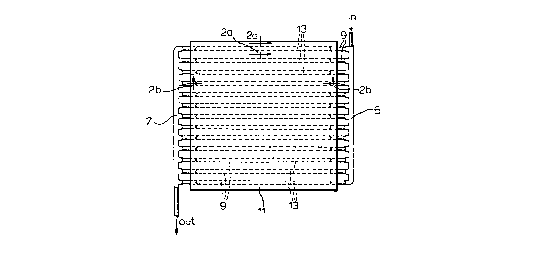Une partie des informations de ce site Web a été fournie par des sources externes. Le gouvernement du Canada n'assume aucune responsabilité concernant la précision, l'actualité ou la fiabilité des informations fournies par les sources externes. Les utilisateurs qui désirent employer cette information devraient consulter directement la source des informations. Le contenu fourni par les sources externes n'est pas assujetti aux exigences sur les langues officielles, la protection des renseignements personnels et l'accessibilité.
L'apparition de différences dans le texte et l'image des Revendications et de l'Abrégé dépend du moment auquel le document est publié. Les textes des Revendications et de l'Abrégé sont affichés :
| (12) Demande de brevet: | (11) CA 2203213 |
|---|---|
| (54) Titre français: | PUITS DE CHALEUR AVEC ACCELERATEUR DE DEBIT DE LIQUIDE DE REFROIDISSEMENT |
| (54) Titre anglais: | HEAT SINK WITH COOLANT ACCELERATOR |
| Statut: | Réputée abandonnée et au-delà du délai pour le rétablissement - en attente de la réponse à l’avis de communication rejetée |
| (51) Classification internationale des brevets (CIB): |
|
|---|---|
| (72) Inventeurs : |
|
| (73) Titulaires : |
|
| (71) Demandeurs : |
|
| (74) Agent: | MARKS & CLERK |
| (74) Co-agent: | |
| (45) Délivré: | |
| (22) Date de dépôt: | 1997-04-21 |
| (41) Mise à la disponibilité du public: | 1997-11-30 |
| Licence disponible: | S.O. |
| Cédé au domaine public: | S.O. |
| (25) Langue des documents déposés: | Anglais |
| Traité de coopération en matière de brevets (PCT): | Non |
|---|
| (30) Données de priorité de la demande: | ||||||
|---|---|---|---|---|---|---|
|
La présente invention vise un puits de chaleur servant à absorber la chaleur non utilisée d'une source chaude, et comportant une surface thermoconductrice reliée à la source en question, une tête avant de diamètre prédéterminé, servant à recevoir une certaine quantité de liquide de refroidissement à un débit volumétrique préétabli; une tête arrière de diamètre prédéterminé servant à refouler le liquide de refroidissement à un débit volumétrique préétabli; un réseau de canalisations reliées par l'extérieur à la source de chaleur et servant à transporter le liquide de refroidissement entre la tête avant et la tête arrière, où la chaleur non utilisée est absorbée par la surface thermoconductrice, et une pièce rapportée insérée dans au moins une des canalisations du réseau et servant à accélérer le débit du liquide de refroidissement de manière à augmenter la performance du puits de chaleur.
A liquid cooled heat sink for removing unwanted heat from a heat source,
comprising a thermal conductive surface connected to the heat source; a front end
head of predetermined diameter for receiving a supply of cooling liquid at a
predetermined volumetric flow rate; a rear end head of the predetermined diameter
for outputting the cooling liquid at the volumetric flow rate; a plurality of pipes of
the predetermined diameter connected outwardly to the heat source for conveying
the cooling liquid between the front end head and the rear end head thereby
withdrawing the unwanted heat from the heat source via the thermal conductive
surface; and an insert in at least one of the plurality of pipes for accelerating flow
of the cooling liquid in the at least one of the plurality of pipes thereby enhancing
thermal performance of the heat sink.
Note : Les revendications sont présentées dans la langue officielle dans laquelle elles ont été soumises.
Note : Les descriptions sont présentées dans la langue officielle dans laquelle elles ont été soumises.

2024-08-01 : Dans le cadre de la transition vers les Brevets de nouvelle génération (BNG), la base de données sur les brevets canadiens (BDBC) contient désormais un Historique d'événement plus détaillé, qui reproduit le Journal des événements de notre nouvelle solution interne.
Veuillez noter que les événements débutant par « Inactive : » se réfèrent à des événements qui ne sont plus utilisés dans notre nouvelle solution interne.
Pour une meilleure compréhension de l'état de la demande ou brevet qui figure sur cette page, la rubrique Mise en garde , et les descriptions de Brevet , Historique d'événement , Taxes périodiques et Historique des paiements devraient être consultées.
| Description | Date |
|---|---|
| Inactive : CIB de MCD | 2006-03-12 |
| Inactive : Lettre officielle | 2004-03-23 |
| Inactive : Inventeur supprimé | 2000-07-05 |
| Inactive : Inventeur supprimé | 2000-07-05 |
| Inactive : Inventeur supprimé | 2000-07-05 |
| Inactive : Inventeur supprimé | 2000-07-05 |
| Inactive : Inventeur supprimé | 2000-07-05 |
| Le délai pour l'annulation est expiré | 2000-04-25 |
| Demande non rétablie avant l'échéance | 2000-04-25 |
| Réputée abandonnée - omission de répondre à un avis sur les taxes pour le maintien en état | 1999-04-21 |
| Demande publiée (accessible au public) | 1997-11-30 |
| Inactive : CIB attribuée | 1997-07-30 |
| Inactive : CIB attribuée | 1997-07-30 |
| Inactive : CIB en 1re position | 1997-07-30 |
| Inactive : Certificat de dépôt - Sans RE (Anglais) | 1997-07-17 |
| Exigences de dépôt - jugé conforme | 1997-07-17 |
| Lettre envoyée | 1997-07-17 |
| Date d'abandonnement | Raison | Date de rétablissement |
|---|---|---|
| 1999-04-21 |
| Type de taxes | Anniversaire | Échéance | Date payée |
|---|---|---|---|
| Taxe pour le dépôt - générale | 1997-04-21 | ||
| Enregistrement d'un document | 1997-04-21 |
Les titulaires actuels et antérieures au dossier sont affichés en ordre alphabétique.
| Titulaires actuels au dossier |
|---|
| R-THETA INC. |
| Titulaires antérieures au dossier |
|---|
| DAVID W. FAST |
| DEO RAMPERSAUD |
| JAMES R.S. BUTLER |
| MARIO J. CHILANSKI |
| MICHAEL RADOSEVIC |